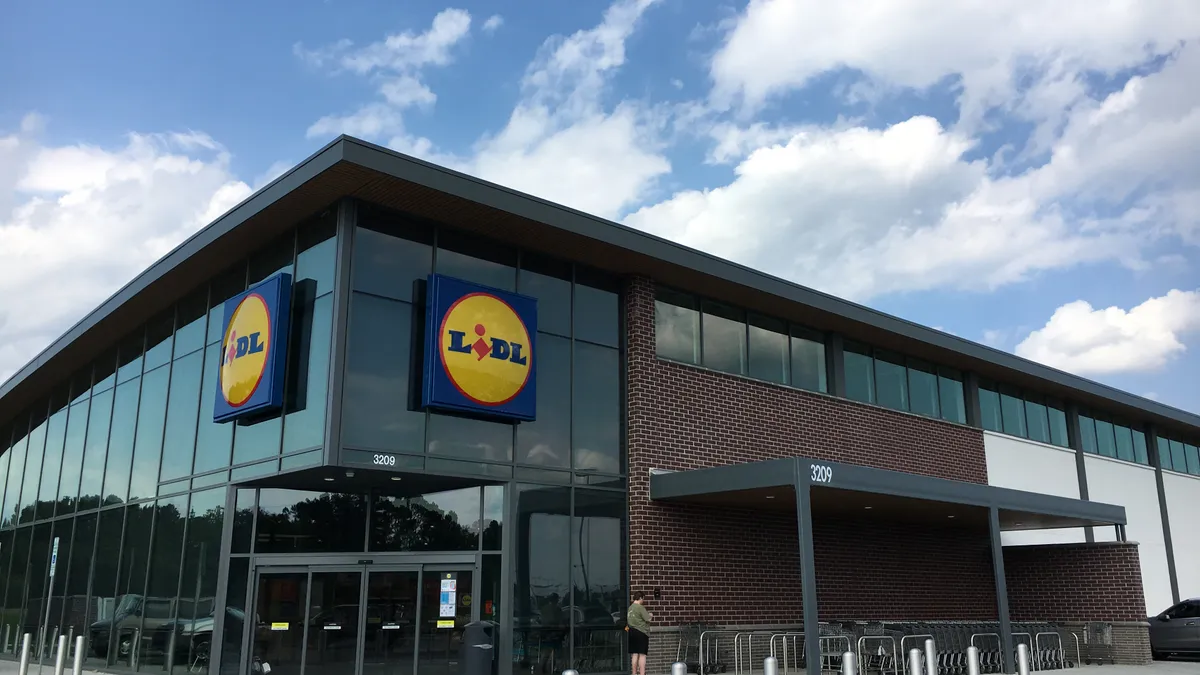Dive Brief:
- A consumer survey from global management consulting firm Oliver Wyman found that shoppers become significantly more enthusiastic about shopping at Lidl after visiting a store, according to a company release. The survey found that 56% of consumers who had shopped Lidl said they would do so more often, compared to 39% who said so before stepping foot inside a store.
- Consumers rated Lidl’s fresh product assortment as equal to that found at national supermarket chains like Kroger and Walmart, according to Oliver Wyman. The survey also found that shoppers of all income levels were visiting the discounter, and that 42% had an annual income over $75,000.
- Along with fellow discounter Aldi, Lidl still poses a significant threat to U.S. grocers, according to Oliver Wyman. “Lidl and Aldi, given their expansion plans could be operating close to 4,000 stores across the U.S. in less than five years, with revenues circa $30 Billion,” the firm noted in its report. “That size shift in consumer spending will put significant stress on incumbent grocery retailers, forcing weaker operators into defensive positions.”
Dive Insight:
Some recent reports have shed an unflattering light on Lidl’s first few months in the U.S. But these findings — including the replacement of Lidl’s U.S. operations head, and a report noting declining store traffic — aren’t as important as what consumers who have so far shopped Lidl are reporting.
“Lidl has demonstrated in country after country they play the long game; tuning their offer, driving customer trial, and connecting with them to achieve repeat purchase,” Oliver Wyman noted in its report. “We believe Lidl are a serious threat and warrant CEO attention and action.”
According to the firm’s findings, Lidl is drawing affluent consumers who rate the discounter’s distinguishing fresh foods highly, and who plan to keep shopping with the chain. Sixty-seven percent of the 500 consumers surveyed said Lidl’s fresh produce and bakery assortment was “great,” while 68% rated the overall shopping experience the same.
Even with Lidl’s reputation for value, 64% of first-time shoppers surveyed said they found the discounter’s prices to be lower than expected.
So if consumers rate Lidl so highly, why did the company lose so many consumers after its opening? According to Wyman, the chain has struggled to build awareness. Its survey showed that, among 2,000 consumers who had never visited Lidl, 92% said this was because they weren’t aware of the chain, the company hadn’t built a location near them, or because they hadn’t yet had time to visit a store. Only 8% said they had no interest in visiting the stores.
These findings jibe with what Bill Bishop, chief architect at consulting firm Brick Meets Click, has observed while studying Lidl. The chain’s lack of brand awareness and its store full of private label products that are entirely new to most U.S. consumers mean its growth may be more of a slow burn.
“People have to experience those products and figure out their pricing proposition,” Bishop told Food Dive.
That said, Bishop noted that Lidl isn’t without its problems. The discounter’s focus on quirky nonfood items is a stretch for U.S. consumers, he said. He also thinks the stores are too big, at around 25,000 square feet per location.
Missteps were to be expected, according to Bishop, but what has surprised him is the low ratings some consumers have given Lidl’s customer service. Brick Meets Click surveyed Yelp and Facebook comments related to Lidl stores, and found numerous comments referencing less-than-impressive store service.
The Wyman report, meanwhile, notes that 34% of Lidl shoppers miss the service they get at mainstream grocery stores, like help bagging groceries.
Lidl has significant work ahead of it, and will likely make significant changes to its stores in the coming months. But the retailer is hardly out of the game, and may slowly but surely build the market share that so many grocers feared it would.
“They didn’t come here to leave,” said Bishop.









